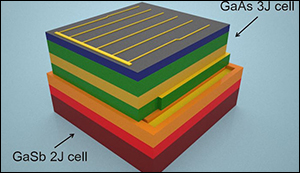Solar cell that captures nearly all energy of solar spectrum
12. 7. 2017 | George Washington University | www.gwu.edu
Scientists have designed and constructed a prototype for a new solar cell that integrates multiple cells stacked into a single device capable of capturing nearly all of the energy in the solar spectrum. The new design converts direct sunlight to electricity with 44.5 percent efficiency, giving it the potential to become the most efficient solar cell in the world.
The approach is different from the solar panels one might commonly see on rooftops or in fields. The new device uses concentrator photovoltaic (CPV) panels that employ lenses to concentrate sunlight onto tiny, micro-scale solar cells. Because of their small size—less than one millimeter square—solar cells utilizing more sophisticated materials can be developed cost effectively.

The stacked cell acts almost like a sieve for sunlight, with the specialized materials in each layer absorbing the energy of a specific set of wavelengths. By the time the light is funneled through the stack, just under half of the available energy has been converted into electricity. By comparison, the most common solar cell today converts only a quarter of the available energy into electricity.
Read more at George Washington University
Image Credit: George Washington University
-jk-




